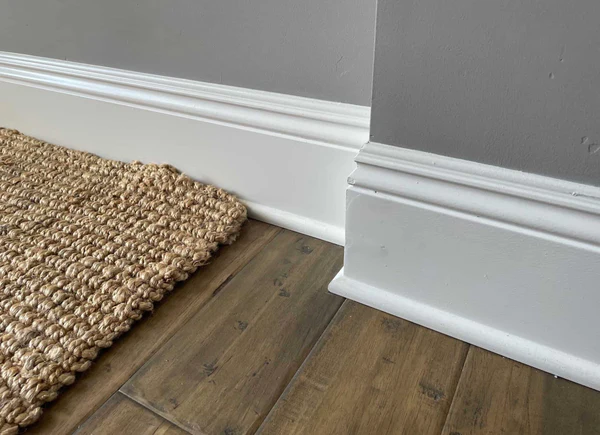Choosing the right baseboard molding can dramatically enhance your interior design. From creating smooth transitions between walls and floors to framing your living spaces with elegance, selecting the perfect style is both an art and a practical decision. With a variety of baseboard molding styles and materials available, homeowners can create subtle elegance or bold statements that suit their interiors, whether it’s a Modern Farmhouse, New Traditional, or Shabby Chic aesthetic.
In this blog, discover a wide range of floor baseboard molding Ideas options, from solid wood to MDF (medium-density fiberboard), making it easy to match the look, color, and finish of your space while ensuring durability and ease of installation.
What is Baseboard Molding and Its Purpose
Baseboard molding is the trim installed along the bottom of interior walls where they meet the floor, creating a clean, finished look. Baseboards are not just functional; they serve as a design element that unites your flooring and walls. Well-chosen baseboard molding:
- Hides gaps between flooring and walls
- Protects walls from scuffs and damage
- Frames rooms elegantly with smooth transitions
- Enhances the style of furniture and décor
Types of Baseboard Styles:
- Beaded baseboards: Offer subtle, linear detailing for classic elegance
- Ornate baseboards: Rich, intricate features for traditional or Victorian interiors
- Smooth baseboards: Minimalist design, perfect for contemporary or Modern Farmhouse interiors
- Square and angular trim: Works well with transitional homes or industrial aesthetics
- Curved baseboards: Adds soft elegance to eclectic or Shabby Chic spaces
FMD Distributor carries all these baseboard styles in multiple finishes, including white baseboards and MDF material baseboards, providing options to suit both modern and traditional interiors.
Materials Matter in Baseboard Molding
Selecting the right baseboard materials affects both durability and appearance:
- Solid wood: Offers natural beauty and can be stained or painted. Ideal for contemporary craftsman or colonial homes. Common species include oak, maple, and walnut.
- Pine Primed Finger-jointed wood: Cost-effective alternative to solid wood, stable, and eco-friendly. Perfect for transitional homes or spaces needing consistent quality.
- MDF (medium-density fiberboard): Smooth, paint-ready surface that works well for modern touch baseboards, minimalist baseboards, and low-profile baseboards.
FMD Distributor provides solid wood, finger-jointed wood, and MDF baseboards suitable for every home, along with floor baseboard molding that simplify installation.
Baseboard Molding Styles and Design Ideas
Choosing baseboard molding styles depends on the room, overall home design, and personal taste. Here are some ideas to inspire your next project:
Modern and Minimalist
- Smooth baseboards with low-profile baseboards
- Works well in contemporary craftsman or urban lofts
- Painted in white, cream colors, or pastels for subtle elegance
Classic and Ornate
- Ornate baseboards with intricate detailing
- Pair with ceiling trim or base caps to elevate rooms
- Ideal for New Traditional and Victorian pile aesthetics
Rustic and Farmhouse
- Blocky baseboards with smooth edges or quarter-round baseboard
- Complements Modern Farmhouse kitchens, living rooms, or dining areas
- Works well with exposed concrete, warm wood flooring, or honey oak
Eclectic and Bohemian
- Curved or decorative baseboards for eclectic or bohemian interiors
- Mix contrasting baseboard colors for visual interest
- Works with patterned walls, punchy fabrics, or grasscloth
Transitional and Vintage Industrial
- Combines understated baseboards with antique-style décor
- Ideal for loft-style apartments or vintage industrial interiors
- Pairs with exposed brick, industrial lighting, or black-stained flooring
FMD Distributor choices: Our materials include MDF ultralight, and Pine primed fj baseboards, along with modern and traditional profiles, allowing homeowners to customize rooms effortlessly.
Choosing the Right Height and Profile
Floor baseboard molding height and profile impact both proportion and perception of space:
- Low-profile baseboards (3–4 inches): Ideal for small rooms, minimalist designs, or Shabby Chic interiors
- Medium height baseboards (5–7 inches): Standard choice for most homes; works in Modern Farmhouse or New Traditional designs
- Tall baseboards (8–12 inches): Creates a luxurious feel, perfect for transitional homes or contemporary craftsman spaces
Profile Options:
- Square or angular trim: Clean, modern, and versatile
- Beaded or decorative trim: Adds detail to formal or classic rooms
- Curved baseboards: Softens the look of eclectic or bohemian interiors
FMD Distributor offers custom-height baseboards and pre-milled profiles that match any ceiling height and design style.
Color and Finish Choices
Baseboard molding ideas aren’t complete without considering color and finish:
- White baseboards: Timeless, works with almost any interior style
- Cream-colored baseboards: Softens room aesthetics, complements pastels or saturated hues
- Contrasting baseboard colors: Creates a bold visual frame for walls or accent walls
- Painted or stained finishes: Match flooring or furniture, such as Chippendale desks or four-poster beds
For unique effects, combine baseboard molding with ceiling trim, crown molding, or base caps to create sophisticated layers and cohesive interiors.
Installation Tips and Tricks
Installing baseboard molding properly ensures longevity and elegance:
Dos:
- Measure accurately and account for corners to achieve perfect alignment. Precise measurements prevent gaps, uneven edges, and wasted material, ensuring baseboards fit neatly along walls and transitions.
- Use a miter saw for precise angles so inside and outside corners join seamlessly. Clean cuts eliminate noticeable gaps and give your baseboard installation a professional, finished appearance.
- Anchor into studs for stability by securing nails or screws directly into structural framing. This keeps baseboards firmly in place, preventing shifting, bowing, or loosening over time.
- Paint or stain MDF or solid wood baseboards before installation to protect against moisture and achieve consistent coverage. Pre-finishing also saves time and prevents paint from staining walls or floors.
Don’ts:
- Avoid gaps or misaligned corners
- Don’t neglect sanding or priming for a smooth finish
- Never use harsh adhesives that can damage walls
FMD Distributor provides installation, how-to videos, and detailed guides, making DIY or professional installation straightforward.
Combining Baseboards With Other Millwork
To create a cohesive look:
- Pair floor baseboard molding with crown molding, door trim, and window casings
- Use decorative baseboards to highlight fireplace surrounds or accent walls
- Match handcrafted features or intricate detailing in built-ins
This approach ensures harmony between interior trim, flooring, and furnishings, enhancing both modern and traditional interiors.
Baseboard Molding for Different Interior Styles
- Modern Farmhouse: Wide, simple baseboards, often painted white or cream
- Shabby Chic: Curved or beaded baseboards, soft pastel finishes
- New Traditional: Tall, ornate baseboards paired with classic six or rococo crown molding
- Vintage Industrial: Blocky, low-profile baseboards, works with exposed concrete and metallic accents
- Contemporary Craftsman: Smooth or angular baseboard styles, minimalist yet refined
FMD Distributor’s variety ensures compatibility across these interior design styles with quality MDF, finger-jointed wood, and solid wood baseboards.
Maintenance Tips for Baseboards
Proper care preserves your baseboard molding:
- Dust regularly with a microfiber cloth or broom to remove dirt, cobwebs, and debris. This prevents buildup in grooves or corners, keeping baseboards looking sharp and freshly installed.
- Clean spills immediately to prevent staining since moisture can seep into the material and leave permanent marks. Prompt action ensures your baseboards maintain their color and finish without long-term damage.
- Avoid harsh chemicals, especially on MDF or finger-jointed wood, because strong cleaners can weaken finishes or cause swelling. Instead, use mild solutions safe for painted or sealed surfaces.
- Repaint or touch up as needed for cream-colored or white baseboards to maintain brightness. These lighter tones show wear more quickly, and occasional painting restores a crisp, clean appearance.
- Use protective measures near kitchen floors or entryways such as mats or corner guards. High-traffic areas expose baseboards to scuffs, dirt, and moisture, so added protection extends their lifespan.
FMD Distributor offers maintenance guidance and durable baseboard products suitable for high-traffic areas.
Conclusion
Knowing how to choose baseboard molding ensures your interiors are both stylish and functional. From smooth modern baseboards and beaded trims to ornate or curved profiles, there’s a style for every room.
FMD Distributor provides a wide selection of baseboard molding styles in solid wood, MDF, and finger-jointed wood, along with installation kits, decorative trims, and floor baseboard molding options. Whether your home features Modern Farmhouse, New Traditional, Shabby Chic, or Contemporary Craftsman interiors, FMD Distributor makes it easy to select, install, and maintain baseboards that enhance your spaces.
Upgrade your interiors with premium baseboard molding. Request a sample or explore our showroom for bulk orders and professional-grade products to complete your home renovation today!
FAQs
- What are modern baseboard styles?
Modern baseboard styles feature clean lines, smooth edges, and minimal ornamentation. They work well in contemporary, modern farmhouse, and minimalist interiors, providing a subtle transition between walls and floors while enhancing room proportions and complementing furniture and décor.
- How to choose baseboards for your home?
When selecting baseboards, consider room height, interior style, and flooring type. For modern spaces, low-profile or smooth baseboards are ideal, while ornate or beaded trims suit New Traditional or Victorian-inspired interiors. FMD Distributor offers a variety of baseboard molding styles for every need.
- What are minimalist modern baseboard styles?
Minimalist modern baseboards focus on simplicity and understated elegance, often with flat profiles, smooth edges, and neutral colors. They pair seamlessly with white walls, exposed concrete, or soft pastels, emphasizing clean architectural lines and subtle sophistication in living spaces.
- What is the current trend for baseboards?
Current baseboard trends in 2025 favor tall, smooth profiles, often painted white or cream, paired with floor baseboard molding in contrasting colors or geometric shapes. Low-profile minimalist trims remain popular in modern and transitional homes for a sleek finish.
- What is the 7% rule for baseboards?
The 7% rule suggests that baseboard height should equal approximately 7% of the ceiling height to maintain visual proportion. For example, a room with 9-foot ceilings would use 6–7-inch baseboards to create balanced, aesthetically pleasing transitions.
Home Improvement

